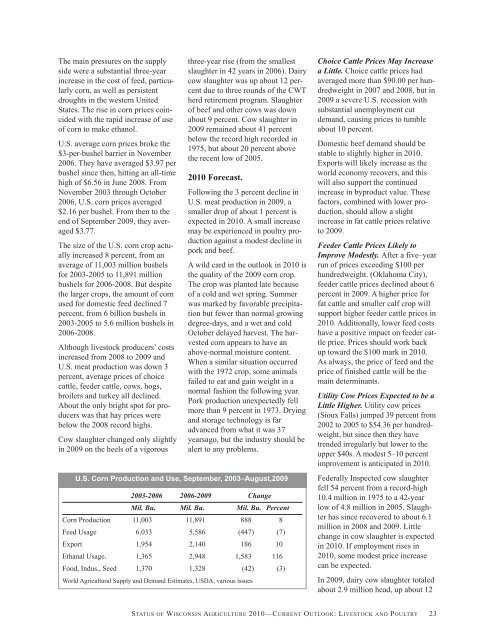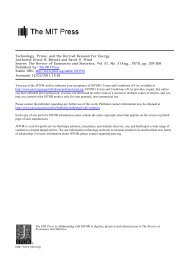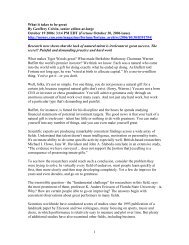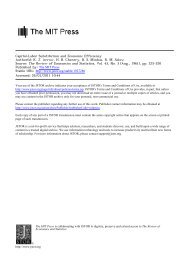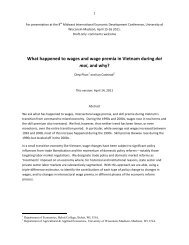Status of Wisconsin Agriculture 2010 - Agricultural & Applied ...
Status of Wisconsin Agriculture 2010 - Agricultural & Applied ...
Status of Wisconsin Agriculture 2010 - Agricultural & Applied ...
Create successful ePaper yourself
Turn your PDF publications into a flip-book with our unique Google optimized e-Paper software.
The main pressures on the supply<br />
side were a substantial three-year<br />
increase in the cost <strong>of</strong> feed, particularly<br />
corn, as well as persistent<br />
droughts in the western United<br />
States. The rise in corn prices coincided<br />
with the rapid increase <strong>of</strong> use<br />
<strong>of</strong> corn to make ethanol.<br />
U.S. average corn prices broke the<br />
$3-per-bushel barrier in November<br />
2006. They have averaged $3.97 per<br />
bushel since then, hitting an all-time<br />
high <strong>of</strong> $6.56 in June 2008. From<br />
November 2003 through October<br />
2006, U.S. corn prices averaged<br />
$2.16 per bushel. From then to the<br />
end <strong>of</strong> September 2009, they averaged<br />
$3.77.<br />
The size <strong>of</strong> the U.S. corn crop actually<br />
increased 8 percent, from an<br />
average <strong>of</strong> 11,003 million bushels<br />
for 2003-2005 to 11,891 million<br />
bushels for 2006-2008. But despite<br />
the larger crops, the amount <strong>of</strong> corn<br />
used for domestic feed declined 7<br />
percent, from 6 billion bushels in<br />
2003-2005 to 5.6 million bushels in<br />
2006-2008.<br />
Although livestock producers’ costs<br />
increased from 2008 to 2009 and<br />
U.S. meat production was down 3<br />
percent, average prices <strong>of</strong> choice<br />
cattle, feeder cattle, cows, hogs,<br />
broilers and turkey all declined.<br />
About the only bright spot for producers<br />
was that hay prices were<br />
below the 2008 record highs.<br />
Cow slaughter changed only slightly<br />
in 2009 on the heels <strong>of</strong> a vigorous<br />
three-year rise (from the smallest<br />
slaughter in 42 years in 2006). Dairy<br />
cow slaughter was up about 12 percent<br />
due to three rounds <strong>of</strong> the CWT<br />
herd retirement program. Slaughter<br />
<strong>of</strong> beef and other cows was down<br />
about 9 percent. Cow slaughter in<br />
2009 remained about 41 percent<br />
below the record high recorded in<br />
1975, but about 20 percent above<br />
the recent low <strong>of</strong> 2005.<br />
<strong>2010</strong> Forecast.<br />
Following the 3 percent decline in<br />
U.S. meat production in 2009, a<br />
smaller drop <strong>of</strong> about 1 percent is<br />
expected in <strong>2010</strong>. A small increase<br />
may be experienced in poultry production<br />
against a modest decline in<br />
pork and beef.<br />
A wild card in the outlook in <strong>2010</strong> is<br />
the quality <strong>of</strong> the 2009 corn crop.<br />
The crop was planted late because<br />
<strong>of</strong> a cold and wet spring. Summer<br />
was marked by favorable precipitation<br />
but fewer than normal growing<br />
degree-days, and a wet and cold<br />
October delayed harvest. The harvested<br />
corn appears to have an<br />
above-normal moisture content.<br />
When a similar situation occurred<br />
with the 1972 crop, some animals<br />
failed to eat and gain weight in a<br />
normal fashion the following year.<br />
Pork production unexpectedly fell<br />
more than 9 percent in 1973. Drying<br />
and storage technology is far<br />
advanced from what it was 37<br />
yearsago, but the industry should be<br />
alert to any problems.<br />
U.S. Corn Production and Use, September, 2003–August,2009<br />
2003-2006 2006-2009 Change<br />
Mil. Bu. Mil. Bu. Mil. Bu. Percent<br />
Corn Production 11,003 11,891 888 8<br />
Feed Usage 6,033 5,586 (447) (7)<br />
Export 1,954 2,140 186 10<br />
Ethanal Usage. 1,365 2,948 1,583 116<br />
Food, Indus., Seed 1,370 1,328 (42) (3)<br />
World <strong>Agricultural</strong> Supply and Demand Estimates, USDA, various issues<br />
Choice Cattle Prices May Increase<br />
a Little. Choice cattle prices had<br />
averaged more than $90.00 per hundredweight<br />
in 2007 and 2008, but in<br />
2009 a severe U.S. recession with<br />
substantial unemployment cut<br />
demand, causing prices to tumble<br />
about 10 percent.<br />
Domestic beef demand should be<br />
stable to slightly higher in <strong>2010</strong>.<br />
Exports will likely increase as the<br />
world economy recovers, and this<br />
will also support the continued<br />
increase in byproduct value. These<br />
factors, combined with lower production,<br />
should allow a slight<br />
increase in fat cattle prices relative<br />
to 2009.<br />
Feeder Cattle Prices Likely to<br />
Improve Modestly. After a five–year<br />
run <strong>of</strong> prices exceeding $100 per<br />
hundredweight. (Oklahoma City),<br />
feeder cattle prices declined about 6<br />
percent in 2009. A higher price for<br />
fat cattle and smaller calf crop will<br />
support higher feeder cattle prices in<br />
<strong>2010</strong>. Additionally, lower feed costs<br />
have a positive impact on feeder cattle<br />
price. Prices should work back<br />
up toward the $100 mark in <strong>2010</strong>.<br />
As always, the price <strong>of</strong> feed and the<br />
price <strong>of</strong> finished cattle will be the<br />
main determinants.<br />
Utility Cow Prices Expected to be a<br />
Little Higher. Utility cow prices<br />
(Sioux Falls) jumped 39 percent from<br />
2002 to 2005 to $54.36 per hundredweight,<br />
but since then they have<br />
trended irregularly but lower to the<br />
upper $40s. A modest 5–10 percent<br />
improvement is anticipated in <strong>2010</strong>.<br />
Federally Inspected cow slaughter<br />
fell 54 percent from a record-high<br />
10.4 million in 1975 to a 42-year<br />
low <strong>of</strong> 4.8 million in 2005. Slaughter<br />
has since recovered to about 6.1<br />
million in 2008 and 2009. Little<br />
change in cow slaughter is expected<br />
in <strong>2010</strong>. If employment rises in<br />
<strong>2010</strong>, some modest price increase<br />
can be expected.<br />
In 2009, dairy cow slaughter totaled<br />
about 2.9 million head, up about 12<br />
STATUS OF WISCONSIN AGRICULTURE <strong>2010</strong>—CURRENT OUTLOOK: LIVESTOCK AND POULTRY 23


